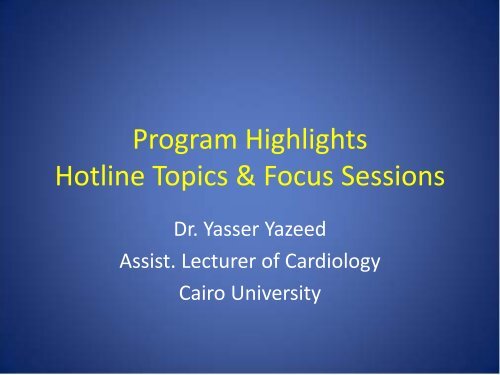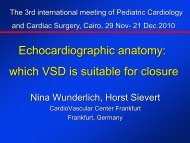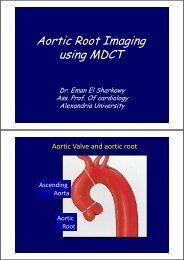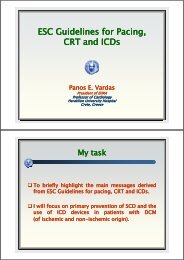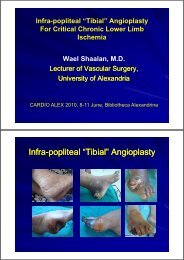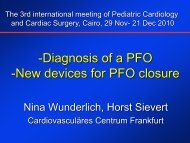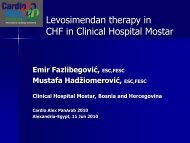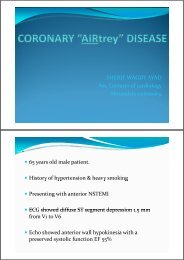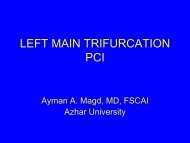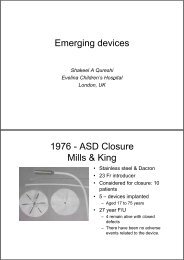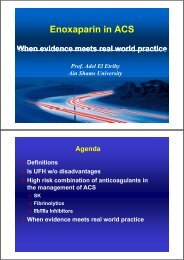Coronary guide wires
Coronary guide wires
Coronary guide wires
- No tags were found...
Create successful ePaper yourself
Turn your PDF publications into a flip-book with our unique Google optimized e-Paper software.
Program HighlightsHotline Topics & Focus SessionsDr. Yasser YazeedAssist. Lecturer of CardiologyCairo University
Hot Line Topics 1
Devices and Strategies to ReduceInfarct SizeHossam Kandil, MDProfessor of CardiologyCairo University
Conclusion• Currently available evidence supports promptprimary PCI with adjunctive simple manualthrombectomy and GPIIb/IIIa inhibition as theoptimal strategy for patients presenting with STEMI• Simple adjunctive manual thrombectomy devicesthat can be deployed rapidly in the overwhelmingmajority of patients are more effective at reducingno-reflow and improving outcome than moreingenious but complex devices that require longerpreparation times and have less universalapplicability
Ahmed Magdy, MD, FACC, FSCAINational Heart Institute, Cairo
PCI post thrombolysis in STEMI:• Prehospital TL+ immediate transferCAPTIM• Rescue PCIfor failed TL• Delayed PCIbefore discharge« Open artery hypothesis »OAT SWISSI II•
PCI post thrombolysis in STEMI:RATIONALE1. Risk of reocclusion high2. Early angiographic risk stratification3. High likelihood of residual complexstenosis despite successful TL Rx
Rescue PCI
(Earlier ) Delayed PCI
Summary• ‘Pharmacoinvasive Strategy’ of routine early PCIwithin 6 hrs after thrombolysis is associated with a6% absolute (46% relative) reduction in thecomposite of death, re-MI, recurrent ischemia, HFand shock• is not associated with any increase in transfusions,severe bleeding despite high use of GP IIb/IIIa inPCI• Benefit seen despite high cath/PCI rates in StandardTreatment group (including ~40% rescue PCI)
Conclusions• For high-risk STEMI patients receiving thrombolysisat non-PCI centres, urgent transfer and PCI within 6hours is associated with significantly less ischemiccomplications and no excess in bleeding• Transfers for PCI centres immediately afterthrombolysis, no waiting to see result ofreperfusion• Regional systems should be developed to ensuretimely transfers of STEMI patients to PCI centres
Radial access: tips and tricksEgyptian Working Group for Interventional Cardiology15 th Annual Scientific MeetingCairo, EgyptDec 2, 2010Thomas Kellerth, MD
• reduce complications– bleeding– MACE?• patient preference• cost-effective• logisticsTRA: a (r)evolution– early ambulation– same-day discharge
the puncture• palpate the route of the arterylengthwise• note the curved route at radial styloidprocess level– good for arterial bloodsamples– bad for radial access• puncture 2-3 cm proximal to thestyloid process• if unsuccessful: try left radial• ulnar artery access is possible
esistance to primary wire• wire should advance with silkcloth feeling• resistance at insertion:– small movements or rotation of needle– check backflow– if in doubt, insert small a/v catheter, retract until backflow– non-hydrophilic PCI wire• resistance higher up– bend wire– non-hydrophilic PCI wire– insert radial introducer halfway• never use force!
• J-tip .035 <strong>guide</strong>wireReaching the aorta and coronaries• resistance in the arm (typically at cubital level):• switch to hydrophilic wire (Terumo Glidewire®)• if still resistance, fluoro the arm and inject dyeslowly in sheath sideport while filming• tortuous subclavian/truncus:• ask pt to inhale deeply• use catheter to steer the wire• switch to hydrophilic wire• never use force!
LDL-C Lowering in ACSlM. Mohsen Ibrahim, MDlCardiology DepartmentlCairo University
ConclusionLDL-C Lowering in ACS• Start statin early–Within the first 24 hs• Be aggressive– Reach a plasma LDL-C level of 60 mg/dl• Large doses of statins are safe,however, not all the statins are thesame
- Benefits of statins can not be predicted entirely from thedegree of LDL-C lowering and may not be simply due toLDL-C lowering (pleiotropic actions)- There is uncertainty regarding the safety of extremely lowlevels of LDL cholesterol less than 25 mg- In many patients a high residual risk of cardiovascularevents persists despite aggressive statin therapy to lowerLDL cholesterol
Comments (2)• Despite on-treatment LDL-C levels reaching nearly60 mg/dl, >60% of treated patients progress to thesame extent expected without lipid-lowering therapy• Advances should be directed to developingcombinations of statins with therapies that treat otherforms of dyslipidemia (high-density lipoprotein,triglycerides,and particle size)• New therapies to increase HDL- C levels are welcomed
Hot line Session 2
MANAGEMENT OF DESRESTENOSISSAMIR WAFA, MDPROFESSOR OF CARDIOLOGYAIN SHAMS UNIVERSITY
RISK OF DES RESTENOSIS• Initial trials : < 10%• Increased to > 20% as DES are used for morecomplex lesions as LM, bifurcation lesions, smallvessels, ISR, vein grafts, ACS and diabetics.• Increased number of patients receiving DESworldwide.• 200,000 cases of DES-ISR / year in USA
PATHOPHYSIOLOGICALMECHANISMS• Stent underexpansion or overexpansion• Stent fracture• Stent malapposition• Nonuniform strut distribution• Nonuniform drug deposition• Polymer disruption due to difficult stent delivery• Polymer hypersensitivity• Drug failure/resistance
MANAGEMENT OPTIONS• Simple PTCA• Cutting balloon• Scoring balloon: nitinol, 3 spiral struts, no slippage, 50% greaterluminal gain.• Restenting with same DES• Restenting with a DES with different mechanism of action• Restenting with a new generation DES• Fully biodegradable stent• Redilatation plus brachytherapy (ICRT)• Redilatation plus oral sirolimus• Redilatation with a drug eluting balloon• CABG
LOGIC APPROACH(Paul Teirestein, Circulation, July, 2010)• IVUS can uncover surprises : underexpansion simpleredilatation with a larger balloon or higher pressureballoon and better to be used if applying another DES.• Time interval between DES and restenosis: if < 6months another stent, if > 6 months balloon only.• The length of the vessel segment that contains ISR, if >10 mm or involves stent edge another stent.
LOGIC APPROACH (cont.)• Use of a different kind of stent.• Use of a second generation DES that have thinner strutsand contain less polymer coating, or biodegradablestent.• Drug eluting balloon.• Restenosis after 2 different DES is considered multipledrug failure CABG (DM) or vascular brachytherapy.• Failure of brachytherapy and not candidate for CABGPTCA with 30 day course of oral sirolimus.
Perioperative MI in PatientUndergoing Noncardiac SurgeryHossam El-Hossary, M.D.Associate Professor of CardiologyCairo University
Perioperative MIScope of the Problem• CAD is the leading cause of nonsurgicalpostoperative deathRisk of perioperative MI / death• No history of ischemic heart disease: 0.1%• History of prior MI: 6%
Risk Assessment Pre-OperativelyPatient Based– High risk conditions– Functional CapacitySurgery Based– Type of Surgery– Emergency surgeryIntervention Based– Medications– Revascularization
Cardiac Risk Stratification Scores• Dripps-ASA• Revised Cardiac Risk Index• Goldman• Detsky
ACC/AHA 2007 Guidelines on PerioperativeCardiovascularEvaluation and Care for Noncardiac Surgery• Evidence – based• Anatomically validated• Clinically validated• More objective• Easy, stepwise approach
Cardiac Evaluation And Care Algorithm ForNon-cardiac SurgeryFleisher, L. A. et al. J Am Coll Cardiol 2007;50:1707-1732
Take Home MessageEstablish patient’s riskAssign procedural riskTest intermediate risk patients undergoing intermediateor high risk surgeryOptimize medical therapyRevascularization when clinically indicatedRisk assessment scoreACC/AHA Guidelines JACC 2007; 50: 1707-1732
Severe carotid and coronary disease: what to do, when and how?PROF DR CİVAN IŞLAKIstanbul Univ.Cerrahpaşa Med Sch.Neuroradiology Sec.
WHAT TO DO?• PATIENT BASED DECISION MAKING• RESPECT THE SYMPTOMATIC AND MORERISKY• IF BOTH SEVERE DO THEM ON ONE SHOT• IF CAROTID INTERVENTION NEEDS TO BEDONE FIRST DO KEY HOLE STENTING
CAD PATIENTS• STRESS MANAGEMENT– LET PATIENT KNOW YOU– ASSURE PATIENT ABOUT PROCEDURE• BLOOD PRESSURE MANAGEMENT– STOP ANTIHYPERTENSIVE MEDICATION– CLOSELY MONITOR BP– RESTART MEDICATION IF NECESSARY• CARDIAC LOAD CARE– AVOID CONTRAST OVERLOAD– MONITOR PERFUSION TROUGH CATH• MYOCARDIAL PERFUSION– MAINTAIN NORMAL BP– INOTROPHIC SUPPORT IF NECESSARY
MEDICATION• CONSIDER 10% CLOPIDOGREL RESISTANCE• CONSIDER FLUCTUATION OF RESPONSE• CLOSELY MONITOR PATIENT’s MEDICALADHERENCE• WAIT FOR 4 WEEKS TO STOP CLOPIDOGRELWHEN NEEDED
Vascular CT
Focus Session 1Adult Congenital Heart DiseaseIntervention
Coarctation of aorta: when tosend to surgeryShakeel A QureshiEvelina Children’s HospitalLondon, UK
Coarctation of aorta: when not to intervene• Unsuitable for intervention in native coarctation• Unsuitable for intervention in recoarctation• Unsuitable for intervention in presence of additionalcomplications
Coarctation of aorta: when not to intervene(cont.)• Unsuitable because of anatomy– Shape of the aortic arch (tortuosity)– Dilated descending aorta– Large aneurysm– Origins of head and neck vessels– Hypoplasia of transverse arch
Coarctation of aorta: when not to intervene(cont.)• In most cases, intervention can be performed• Appropriate equipment needs to be availablee.g covered stents• Very few occasions in adults when surgeryneeded for aortic coarctation
Do we need to Stent Coarctationof the Aorta?22 Years Follow-up Results ofBalloon Angioplasty for DiscreetNative Coarctation of the Aortain Adolescents and AdultsMohamed Eid Fawzy, FRCP(London), FACC, FESC
Objective‣This study evaluated the longtermup to 22 years of follow-upresults of balloon angioplasty inadolescent and adult patients withdiscrete (shelf like) coarctation ofthe aorta
Discrete Coarctation (arrow)
Immediate Results¥ Success in 57 out of 62 pts (92%) (gradient≤ 20). The gradient decreased from 60±22mmHg to 8.5±8 mmHg¥ The coarctation gradient decreased to ≤10mmHg in 49 pts. Of these 49 pts, 25 pts hada gradient of zero.¥ In 5 pts, the gradient was 11-15¥ In 3 pts, the gradient was >15-20
Long-term follow-up results¥ Two patients (living abroad) were lost to follow-up.¥ Follow-up catheterization and angiographyperformed 1 year post-dilatation in 50 pts.There was a further decrease in gradient acrossthe coarctation site from 8.5±8 to 5±6.4 mmHg,(P=0.01).¥ 58 pts were followed-up by MRI or CT Scan 64slides and Echo for a median of 13.4 (range 1- 22)years. No new aneurysm or recoarctation wasnoted.
ConclusionThis study demonstrated excellent long-term results ofballoon angioplasty for native discrete (shelf like)coarctation in adolescent and adult patients. The resultsof balloon angioplasty compare favorably with reportedresults of surgical aortic coarctation repair or stenting.We recommend balloon angioplasty as the first optionfor treatment of discrete coarctation in adolescent andadult patients. This technique should not be used inpatients with severe hypoplasia of the isthmus ortransverse aortic arch, recurrent coarctation and tortuouscoarctation.
Focus Session 2Peripheral / Carotid Intervensions
Focus Session 3Tools Of The Trade: Guide WireSelection
<strong>Coronary</strong> <strong>guide</strong> <strong>wires</strong>Sherif ElTobgi MDProfessor of cardiology, Cairouniversity
<strong>Coronary</strong> <strong>guide</strong> <strong>wires</strong>Performance characteristics: Fig.21.Steerability: the ability to steer the wire in acontrolled fashion.2.Torque control: the faithful transmission ofrotational force at the proximal end of the wireto its distal end.3.Trackability: the ability of the <strong>guide</strong> wire tonavigate the anatomy of the coronary artery.
<strong>Coronary</strong> <strong>guide</strong> <strong>wires</strong>Performance characteristics Fig.2 (cont.):4.Flexibility: the ability of the wire to bend andchange its direction when met with resistance.5.Support: the ability of the <strong>guide</strong> wire tosupport the tracking of another device over it,through a given coronary anatomy.6. Pushability & Tip Load.
<strong>Coronary</strong> <strong>guide</strong> <strong>wires</strong>Fig.2Performance characteristics (cont.):7. Lubricity.8. Crossing.9. Tactile Feed back.10. Safety.
<strong>Coronary</strong> <strong>guide</strong> <strong>wires</strong>Fig.2
<strong>Coronary</strong> <strong>guide</strong> <strong>wires</strong>Wires• BMW / universal• Galeo• Luge• Rinato / Prowater• Runthrough• Spring coil• High flexibility• Soft tip ≤ 1 gm• Safe
<strong>Coronary</strong> <strong>guide</strong> <strong>wires</strong>Plastic jacket <strong>wires</strong>:• Soft (1-2 gm):Fielder FC, XTWhisper LS, MSChoice PT• Medium (2-4 gm):Pilot 50, 150, 200PT2 LS, MS• Lubricity / crossing• Tortuous vessel• Tight complexlesions• CTO microchannels
<strong>Coronary</strong> <strong>guide</strong> <strong>wires</strong>Stiff <strong>wires</strong>:• Medium (2-3 gm):Miracle 3IntermediateCross-it 100, 200• Hard (4-12 gm):Miracle 4-12Carquest 9,12Cross-it 300, 400Progress 4-13• Spring coils• High penetrationpower• Low flexibility• CTO
Thank You Very Much


